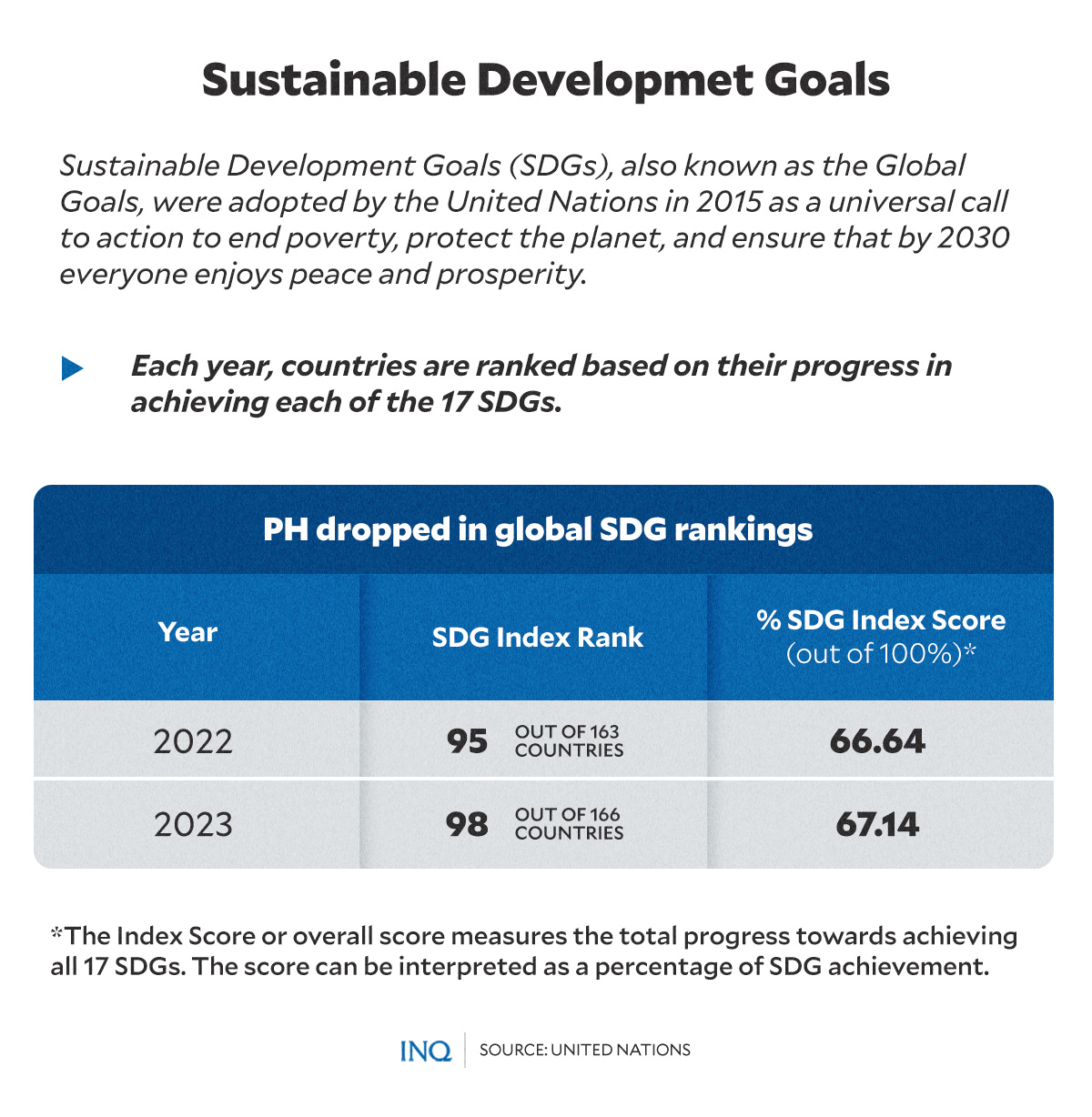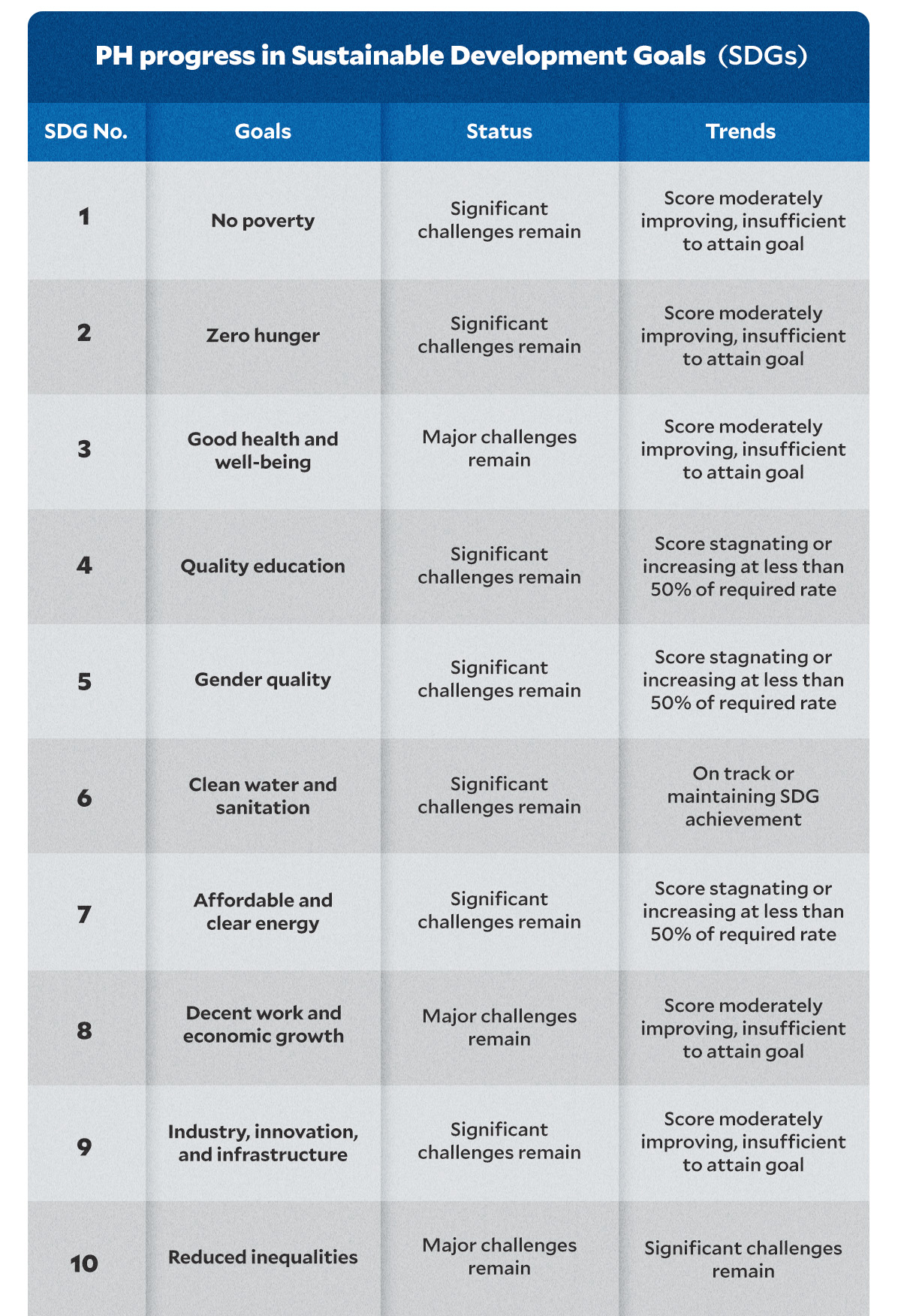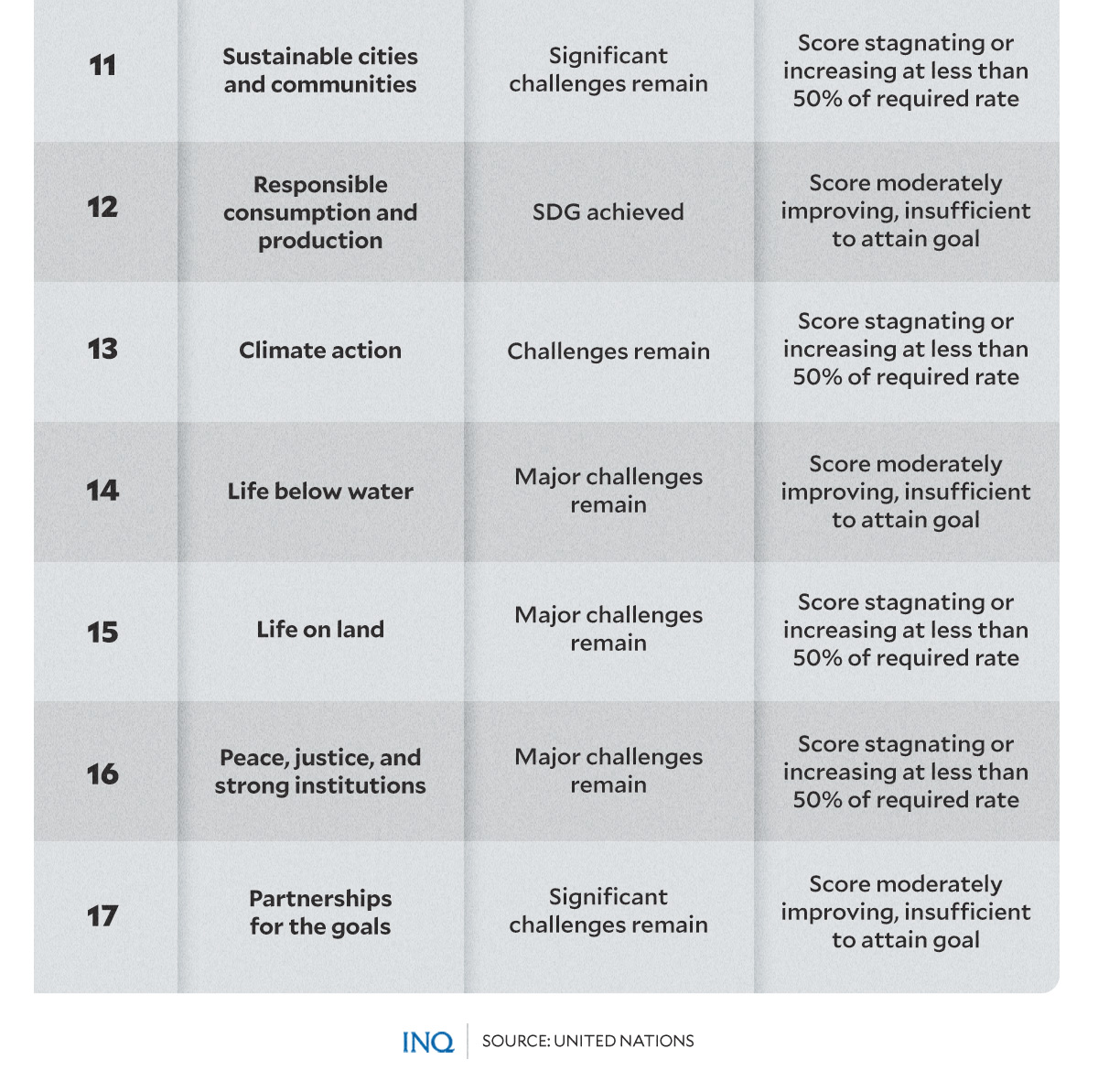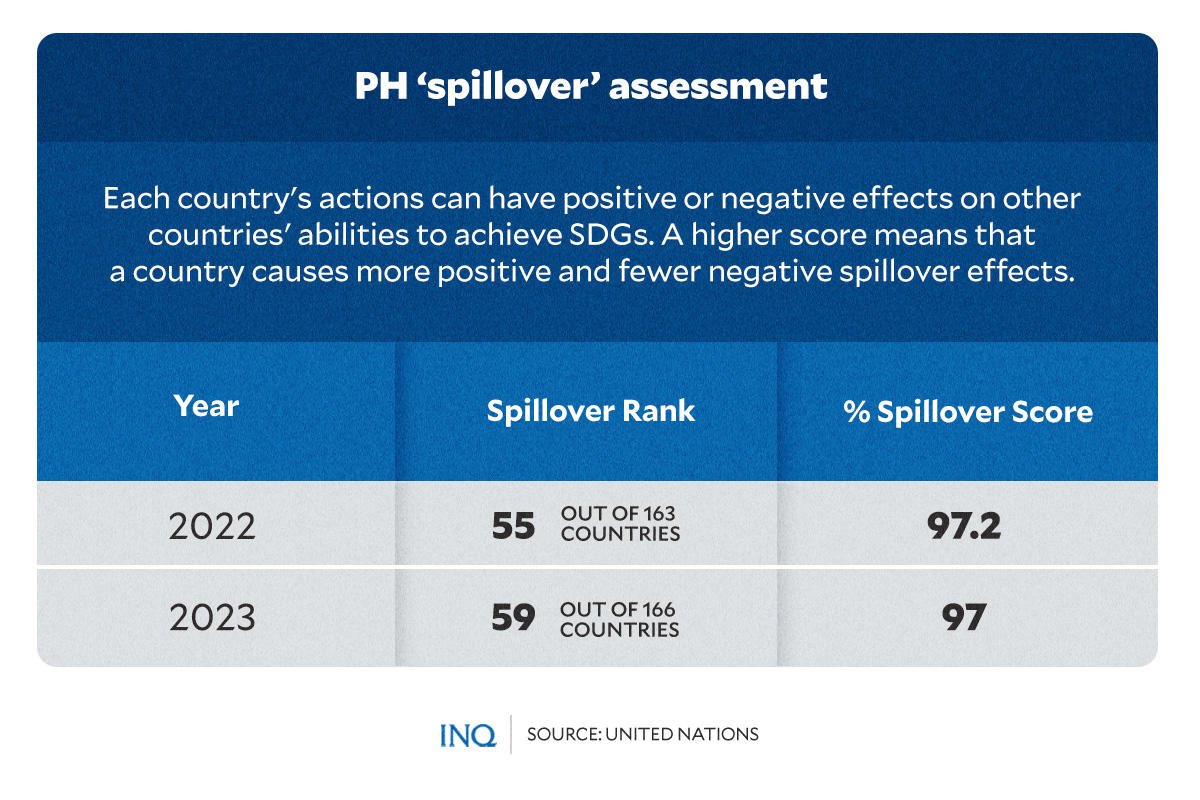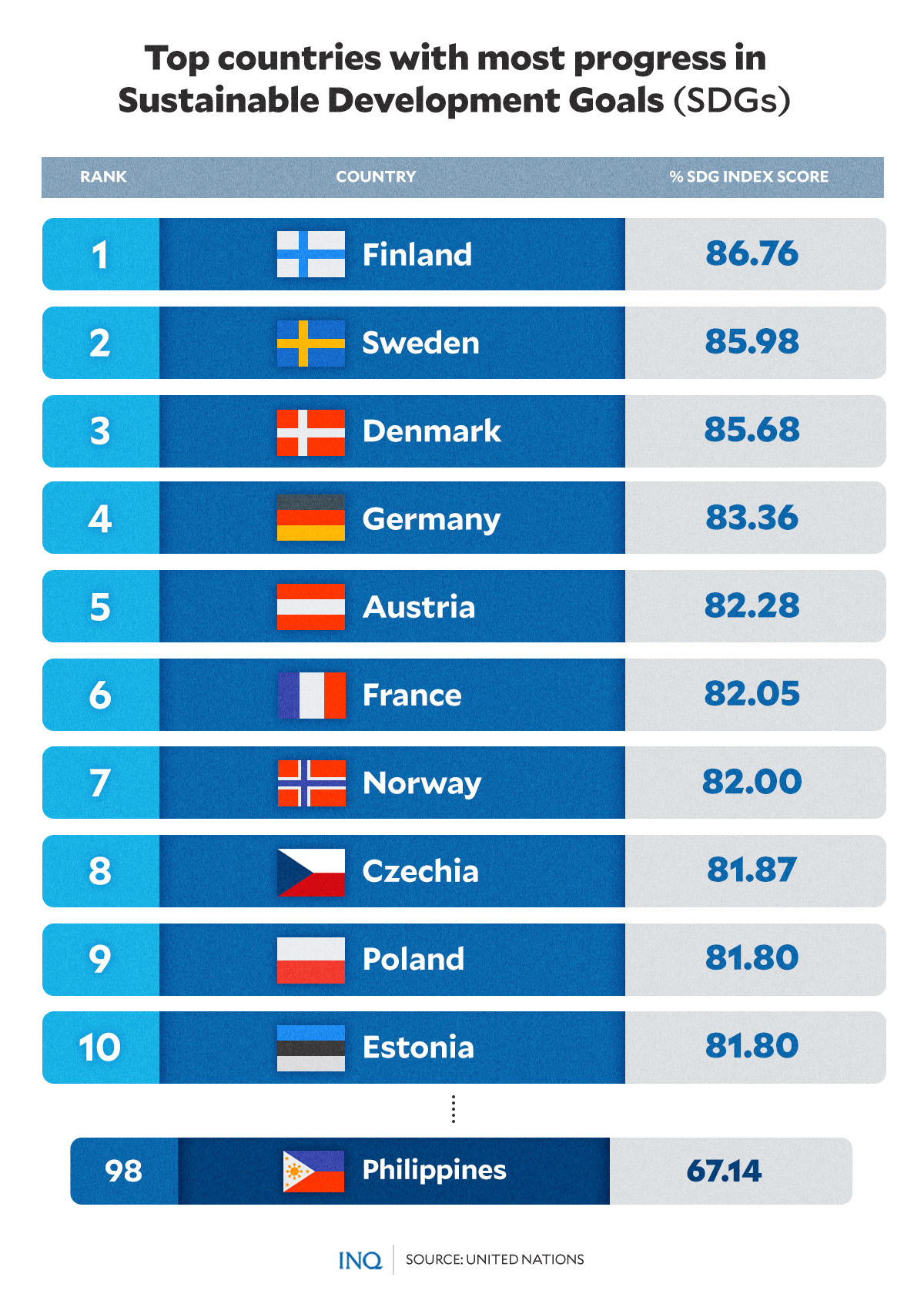PH among countries lagging in UN development targets
MANILA, Philippines—At the midpoint of the implementation of the Sustainable Development Goals (SDGs), a sobering reality emerges: the world is falling short of meeting most of these goals by 2030.
In 2015, United Nations (UN) member states, including the Philippines, adopted the SDGs as a universal target to end poverty, protect the planet, and ensure that by 2030, everyone would live in peace and prosperity.
“Leave no one behind,” said the UN in a special edition of the SDG report.
“That defining principle of the 2030 Agenda for Sustainable Development is a shared promise by every country to work together to secure the rights and well-being of everyone on a healthy, thriving planet,” the UN said.
“But halfway to 2030, that promise is in peril,” it said.
Article continues after this advertisement“The Sustainable Development Goals are disappearing in the rear-view mirror, as is the hope and rights of current and future generations,” the UN said.
Article continues after this advertisement“A fundamental shift is needed – in commitment, solidarity, financing, and action – to put the world on a better path. And it is needed now,” it added.
In the case of the Philippines, 2023 has witnessed a slower pace of advancement or even a step backward compared to the progress made in the previous year.
Sounding the alarm
“Halfway to the deadline for the 2030 Agenda, the SDG Progress Report; Special Edition shows we are leaving more than half the world behind,” said UN Secretary-General António Guterres.
“Progress on more than 50 percent of targets of the SDGs is weak and insufficient; on 30 percent, it has stalled or gone into reverse. These include key targets on poverty, hunger and climate,” he said.
“Unless we act now, the 2030 Agenda could become an epitaph for a world that might have been,” he added.
To better understand the 2030 Agenda, think of it as a big plan that the whole world agreed on to make our planet a better place by the year 2030. It’s like a roadmap with 17 main goals, known as SDGs, which cover things like ending poverty, protecting the environment, making sure everyone has good health and education, and more.
These 17 main goals are global to-do lists, which are composed of 140 different goals or tasks. However, as the world reaches halfway to 2030, the UN said there are some problems in making progress in achieving these tasks.
“The latest global-level data and assessments from custodian agencies paint a concerning picture: of the approximately 140 targets that can be evaluated, half of them show moderate or severe deviations from the desired trajectory,” the UN stressed.
“Furthermore, more than 30 percent of these targets have experienced no progress or, even worse, regression below the 2015 baseline,” it explained.
Results of the evaluation underscore the pressing need for heightened efforts to steer the SDGs back on track and make strides toward a sustainable future for all.
“The task ahead is daunting, but it is not impossible,” said Li Junhua, UN undersecretary-general for economic and social affairs.
“With just seven years left to deliver transformational change, political leaders and public institutions will need to rally all stakeholders around the SDGs and strengthen collaboration, while building trust and accountability,” Junhua added.
“Steps like regulatory innovations that align private sector governance models with sustainable development objectives could spark significant change if applied soon enough.”
Country ranking
Countries that are actively working to implement and achieve SDGs — often referred to as “SDG implementers” or “SDG adopters” — are ranked annually based on their progress in achieving the goals.
The Index Score, or overall score, is used to measure the total progress of each country in achieving all 17 SDGs. The score can be interpreted as a percentage of SDG achievement. A score of 100 indicates that all SDGs have been achieved.
A higher SDG Index Score generally indicates better progress in achieving the SDGs, while a lower score suggests that a country may be facing challenges in meeting its sustainable development targets.
The most recent rankings from the UN Sustainable Development Solutions Network (SDSN) revealed that Finland, Sweden, Denmark, Germany, and Austria stand at the forefront in terms of their accomplishments and advancements in implementing SDGs.
At the midpoint of the 2030 Agenda, these five nations have already achieved substantial progress, with SDG Index Scores of 86.76 percent, 85.98 percent, 85.68 percent, 83.36 percent, and 82.28.
In the latest assessment by the UN SDSN, the Philippines secured the 98th spot among 166 countries in 2022, slipping three places compared to its 95th position among 163 countries in 2021.
READ: PH halfway through in achieving SDGs as 2030 deadline looms
Despite this slight drop in rankings, the country’s Index Score improved, increasing from 66.64 percent in 2021 to 67.14 percent in 2022.
Data from the 2023 Sustainable Development Report further revealed that 34.7 percent of SDG targets for the Philippines have either been achieved or are on the right track. Approximately 37.5 percent have made limited progress, while 27.8 percent of the targets have shown a deteriorating status.
SDG implementation: Where do we stand?
Out of the 17 SDGs, the Philippines was able to achieve only one so far: SDG 12, which encourages more sustainable consumption and production patterns through various measures, including specific policies and international agreements on the management of materials that are toxic to the environment.
The UN SDSN said the country is on track or is currently maintaining SDG achievement, which covered efforts in reducing solid and electronic waste and minimizing sulfur dioxide (SO₂ ) and nitrogen emissions.
For SDG 6 (clean water and sanitation), data showed that although the Philippines was already on track or maintaining SDG achievement, challenges — both major and significant —remain, specifically in achieving these targets:
- Target 6.1: By 2030, achieve universal and equitable access to safe and affordable drinking water for all
- Target 6.2: By 2030, achieve access to adequate and equitable sanitation and hygiene for all and end open defecation, paying special attention to the needs of women and girls and those in vulnerable situations
- Target 6.3: By 2030, improve water quality by reducing pollution, eliminating dumping and minimizing the release of hazardous chemicals and materials, halving the proportion of untreated wastewater, and substantially increasing recycling and safe reuse globally
- Target 6.4: By 2030, substantially increase water-use efficiency across all sectors and ensure sustainable withdrawals and supply of freshwater to address water scarcity and substantially reduce the number of people suffering from water scarcity
The data also showed that the country continues to face challenges in achieving SDG 13 (climate action) after efforts to combat climate change and its impacts were seen stagnating.
READ: Manila Water recognizes the role of its women leaders in achieving sustainability goals
The country is also facing significant challenges in some other SDGs, such as:
- SDG 1: No poverty
- SDG 2: Zero hunger
- SDG 4: Quality education
- SDG 5: Gender equality
- SDG 6: Clean water and sanitation
- SDG 7: Affordable and clean energy
- SDG 9: Industry, innovation and infrastructure
- SDG 11: Sustainable cities and communities
- SDG 17: Partnership for the goals
READ: PH SDG score: Good in curbing poverty, teenage smoking
The Philippines faces major challenges in achieving six significant SDGs:
- SDG 3: Good health and well-being
- SDG 8: Decent work and economic growth
- SDG 10: Reduced inequalities
- SDG 14: Life below water
- SDG 15: Life on land
- SDG 16: Peace, justice, and strong institutions
Positive influence
Aside from their overall score and ranking, UN member states are also ranked by their spillover scores.
“Countries are ranked by their spillover score. Each country’s actions can have positive or negative effects on other countries’ abilities to achieve the SDGs,” the UN SDSN explained.
“The Spillover Index assesses such spillovers along three dimensions: environmental & social impacts embodied into trade, economy & finance, and security,” it added.
A higher score indicates that a country causes more positive than negative spillover effects.
In 2022, the Philippines held the 59th position among 166 countries, with a spillover score of 96.98. This represents a drop from its previous ranking of 55th among 163 countries, where it had a higher spillover score of 97.21.
The UN SDSN noted that the country had achieved several SDG indicators under the three dimensions of development (environmental and social impacts embodied into trade, economy and finance, and security).
Key areas for urgent action
“The SDGs are the universally agreed road map to bridge economic and geopolitical divides, restore trust, and rebuild solidarity,” Guterres said.
“Failure to make progress means inequalities will continue to deepen, increasing the risk of a fragmented, two-speed world. No country can afford to see the 2030 Agenda fail,” he added.
Junhua, meanwhile, emphasized that the 2030 Agenda remains the clearest blueprint of humanity’s highest aspirations.
“When historians write about the twenty-first century, they will judge leaders and policymakers by whether they have succeeded in transforming this blueprint into reality,” said Junhua.
“Back in September 2015, when global leaders met to adopt the SDGs, they declared that ‘the future of humanity and of our planet lies in our hands’,” Junhua said.
“At this midpoint, these words are truer than ever. It’s now up to us to ensure that the Sustainable Development Goals are achieved — in full and on time,” he added.
The UN identified five key areas for urgent action amid the “sobering picture” painted by the results of the comprehensive assessment of global progress in achieving the SDGs:
- Heads of State and Government should recommit to seven years of accelerated, sustained, and transformative action — both nationally and internationally — to deliver on the promise of the Sustainable Development Goals.
- Governments should advance concrete, integrated, and targeted policies and actions to eradicate poverty, reduce inequality, and end the war on nature, with a focus on advancing the rights of women and girls and empowering the most vulnerable.
- Governments should strengthen national and subnational capacity, accountability and public institutions to deliver accelerated progress towards achieving the Sustainable Development Goals.
- The international community should recommit at the SDG Summit to deliver on the Addis Ababa Action Agenda and to mobilize the resources and investment needed for developing countries to achieve the Sustainable Development Goals, particularly those in special situations and experiencing vulnerability.
- Member States should facilitate the continued strengthening of the United Nations development system and boost the capacity of the multilateral system to tackle emerging challenges and address Sustainable Development Goals-related gaps and weaknesses in the international architecture that have emerged since 2015.
RELATED STORY: UN development targets seen unreachable by 2030 in Asia Pacific

